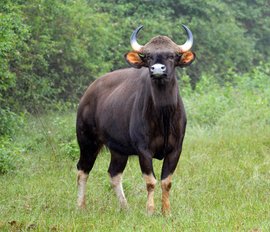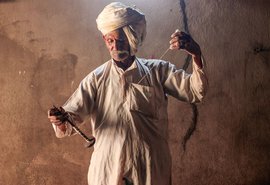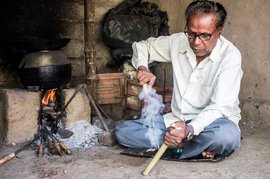Laxmibai’s skills hang by a rough thread
PARI volunteer Sanket Jain aims to traverse 300 villages across India and, among other stories, produce this feature: a photograph of a rural scene or event and a sketch of that photograph. This is the ninth in the series on PARI. Draw the slider either way to see the photo or sketch in full
“I will never stop weaving thread,” says Laxmibai Dhangar, smiling as she looks at her charkha . Laxmibai, now 70, has been hand-spinning thread from sheep’s hair and wool for more than half a century. She has extraordinary skills – for which there is no market.
In the past, she made threads for 10 hours a day. “My mother in law had stored 12 sacks [approximately 120 kilograms] of sheep’s hair just before I got married [at around the age of 15], recalls Laxmibai. “Labouring every day for 8 to 10 hours, I took six months to make threads out of those 12 sacks,” she recalls. Now it’s down to just two hours a day.
Laxmibai is a Dhangar, traditionally a goat and sheep herder community (now classified as Other Backward Classes or OBCs in Maharashtra). She lives in Adur village in Karvir block of Maharashtra’s Kolhapur district. Here, sheep’s hair and wool are removed twice a year. After Diwali in the month of October-November and after the festival of Akshaya Tritiya in April-May.
“For centuries, only women have been spinning the thread while men have been shearing the sheep and also milking them,” Laxmibai says. Traditionally, only men would go out grazing the animals, but now women too join them.
The Dhangars now pay Rs. 8 a kilogram to have the rough hair made soft and uniform using machines. This task is done by people in nearby villages. Earlier, the women did it by hand, using bow-shaped wooden tools.
The softened hair is spun into a thread on a charkha . This thread is sent to the Sangars (a Dhangar sub-caste traditionally skilled in weaving wool using handlooms). Sangar men then weave ghongadya (blankets) out of it. For weaving a ghongadi 7.5 by 2.5 feet in size, the Sangars charge Rs. 400 and require six kilos of sheep’s hair thread. The Dhangar women include the cost of many hours of labour in spinning the thread – and then try to sell these ghongadya for Rs. 1,300 a piece.
“Selling at Rs. 1,300 has become difficult now. [Machine-made] bedsheets cost only Rs. 500 and people don’t understand the labour involved in crafting a ghongadi ,” says Laxmibai, pointing to one she has been unable to sell in three months. A decade ago, they managed to sell at least four of these in a month. Now it’s down just to one.
Earlier, people from the villages of Kalambe Tarf Kale, Bhamate, Chuye, Koparde (all in Kolhapur district) used to come to her home to buy ghongadya . “Now only the older people buy them,” she says.
“Three decades ago, close to 30 Dhangar women used to spin the thread in my village. Now, there’s just a dozen of us,” estimates Laxmibai. The main reasons for this decline: poor returns, old age, and the lack of demand for ghongadya .
For the countless hours of work she puts into spinning, labouring in the fields, and selling ghongadya , Laxmibai earns less than Rs. 5,000 a month. Until around a decade ago, Laxmibai doubled up as an agricultural labourer each season – in the fields of others in Adur village. For eight hours of work daily, she was paid Rs. 100. “My parents too worked as agricultural labourers and they couldn’t afford to send me to any school,” she recalls.
Every year, her husband, Shamrao Dhangar, 75, used to graze around 200 sheep and goats across thousands of kilometres in the villages of Pune, Sangli, Kolhapur, Satara and Solapur districts in Maharashtra, and the villages of Belgaum district in Karnataka. The Dhangars usually migrate for at least three months before the onset of heavy rains in western Maharashtra (from June to September).
Shamrao and Laximabi’s two sons, Birdev, 35, and Suresh, 40, collectively own just 64 sheep and 6 goats. Talking about the reducing number, Shamrao says, “Everyone cultivates sugarcane these days even on the grazing land – and farmers don’t let us enter their fields. It’s difficult to graze these animals now.”
Their two daughters, Bharti, 40, and Sangita, in her early 30s, are married. Of the two, Bharti has continued spinning thread. “My daughter-in-law keeps saying: ‘I can’t do this. Even working as an agricultural labourer is better than this’,” Laxmibai says. Many of the younger lot are exploring other options. Jobs in industries, where they exist, for instance.
Laxmibai’s own daily work on the charkha has come down to two hours. Growing backaches have ensured that, along with a lack of demand for her skill. “The younger generation will never take to this occupation. My only dream is to get a fair price for our ghongadis – the symbol of our hard work,” she says.



